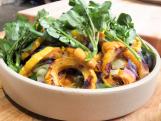Squash Fears of Squash (and Make Awesome Squash Recipes)

This isn't summer, folks. Gone are the easy days of slicing up raw cucumbers and tomatoes, sprinkling them with salt and calling it a meal. Fall vegetables take a lot more determination and know-how. Winter squashes —those vibrantly-colored gourds that double as centerpieces — are a case in point, with their intimidatingly hard shell. But once you crack your way in, delicious fall and winter dishes are yours for the making. So let's eliminate those concerns:
How do I cut them? Use a sharp, large knife. Start to cut by placing the knife on top and giving it a good whack in the center of the squash. Cover the sharp end of the knife with a towel and rock the knife back and forth.
How do I choose a good one? A ripe squash should feel heavy and have no soft spots. Some are sweeter than others, so when in doubt go by flesh color — the more orange-y ones tend to be sweeter than the yellow ones.
Can I eat the skin? It depends on the variety. You can eat the skin of delicata squash (which also means super easy preparation — slice up half-circles and add them to a stir-fry), sweet dumpling and acorn squash, but other ones you'll want to peel, either before or after cooking. Try these wedges of acorn squash baked in a sweet, crunchy coating.
How can I cook them? Roasting is always a safe bet. For lots of squash, it's as simple as cutting it in half, scooping out the seeds and baking cut-side down on a baking sheet until you can pierce it with a fork. Then you can scoop out the flesh to mash, or stuff the cavity with a filling, as in Alton Brown's stuffed acorn squash. Turn pumpkin into a savory sauce that can jazz up everything from grilled vegetables to veggie burgers if you make this Spicy Pumpkin-Curry Crazy Sauce or make a Thai pumpkin curry. Another surefire way to use them is to turn them into a creamy soup. You can even use it as a soup bowl (pictured above)!
What other interesting ways can I use them? Winter squash does really well in lightened-up comfort foods. Try adding it to mac & cheese—it keeps the dish creamy & orange, but adds nutrition (lots of fiber and vitamin A) and lightens it up calorie-wise. You can use them same trick in Pumpkin Lasagna. Butternut squash gets the crinkle-cut fry treatment in these butternut squash fries. You can also mix up a basic tomato sauce for pasta with butternut squash. For an indulgent take, use it in ice cream. Or bring it to breakfast with this Pumpkin-Ginger Smoothie. You can also use spaghetti squash to make a 90% veggie dish that’s 100% satisfying. Top the strands of baked spaghetti squash with eggplant parmesan-inspired sauce…it's sooooo good, yet soooo healthy. Or try it with a simple marinara.
Is the canned variety good enough? Canned and BPA-free-boxed squash purees are readily available and can offer a great way to get certain squashes into your meals. Canned pumpkin is the most easy to find, but also check out canned butternut squash. Try canned pumpkin not just in baked goods, but also savory dishes, like this curried pumpkin dip or pasta with sausage.












